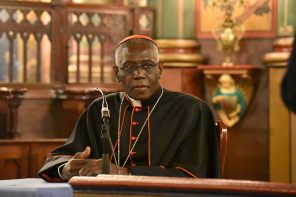What inspired you to write Winckelmann and the Vatican’s First Profane Museum?
This book was actually born out of what I thought was a fairly simple question. When I was in Rome for the first time on an NEH seminar, in the summer of 2000, I paid my first long visit to the Vatican Museums. I was surprised to read that something they called “the Profane Museum” had opened inside the Apostolic Palace in 1761. It was just one sentence in an otherwise copious description of the history of the Vatican Museums, so I was intrigued by that detail-less detail.
While the dates proved to be a little fuzzy, this was nonetheless a very early development—fully a generation before the explosion of classical art museums we see throughout Europe in the first two or three decades of the 19th century. So, how and why was this done so early inside the Vatican Palace was one question. And what in the world did the Library administration intend when they called their museum “profane”? That’s what I went to the Vatican Library’s Secret Archives to find out. I didn’t expect it to take eight years to find some answers, though.
What are some of the biggest misconceptions about your topic?
Given that so much of the story I tell in the book is new, there aren’t as many misconceptions to overcome as there simply gaps in knowledge needing to be filled. That said, several commonplace ideas will need to be adjusted if what I argue is correct. Two come to mind, and while both of them may seem like scholarly quibbles, they actually bleed out into matters of deep cultural significance.
The first is this: a few years ago the Vatican Museums put together a special exhibition celebrating what they called the 500th anniversary of the Vatican Museums. The date they were actually commemorating was the date when the very famous Laocoön Group was discovered at a construction site in Rome. The Pope heard about the discovery, and sent Michelangelo to assess the statue’s value; when even that great visual artist walked away flabbergasted by its quality, the Pope had it brought to the Vatican. But there was no museum, not then and not until much later. Rather, Julius II, a famous (and infamous) Renaissance pope, built a very traditional-looking sculpture garden at a place called the Belvedere. It was utterly private, since most Church elites believed that they understood how to view such things, but that the “hoi polloi” might be confused or, God help them, tempted by such pagan visual forms.
Some pretty clear evidence for the edginess of the whole thing comes less than fifty years later when the last non-Italian pope until John Paul II, a Dutch pope (Adrian VI), came to Rome for the first time. The cardinals proudly gave him a tour of the Belvedere. He was shocked and outraged, informing them (in Latin no less) that “these are nothing but pagan idols!” He threatened to sell off the whole collection, and in the interim built cabinets for them, locked the doors, and kept the key to himself. He died within the year.
The novelty of the Profane Museum, then, had a lot to do with its publicity. The Profane Museum was a room full of pagan antiquities curated by the founder of modern Art History as we know it, a Catholic convert from Saxony named Johan Joachim Winckelmann (1717-1768). He arranged the thing to be a sort of transitional space that leads you from the private space of the Vatican Library to the suddenly, shockingly public space of the Museums. The end of the tour he choreographed was the courtyard where his two favorite statues were, the Laocoön Group and the Apollo Belvedere. And he ensured that they were all on public display—not in 1503, but in 1767.
That leads to the second major misconception the book addresses, in its pivotal central chapter. In a word, it’s not quite right to say that Winckelmann was gay, and it is certainly mistaken to claim that his sexual identity is what inspired him to his lifelong devotion to Greek sculpture. It is fairly clear that Winckelmann’s personal tastes were homoerotic, and he very clearly insisted that the art observer who possesses no appreciation for male beauty will be incapable of understanding Greek art. But sexual identity—the notion that the gender of your sexual object choices is central to who you are—was not a concept readily available to him or anyone else at the time.
Psychologists in Germany and the U.S. developed that idea a century later. It is important to observe how rapidly some seismic new ways of seeing emerge in the modern period, and not just in museums. What I argue in the book is that Roman ecclesiastical elites didn’t much care what people did sexually, but they cared a great deal about what they did religiously. So the real novelty, even the scandal if you will, of Winckelmann’s Vatican career was his subversive flirtation with pagan form. “Catholic or Protestant” mattered a lot more to these people than “gay or straight.” So, religion matters more than sex, and the two can’t be equated; that’s the somewhat un-contemporary argument I’m making.
What’s the essential takeaway for readers?
Art museums are funky places. The very name comes from a Greek word meaning “shrine to the muse,” so the casual or not-so-casual flirtation with pagan form is central to their conception and design. What the Vatican’s “Profane museum” enacted were what I take to be some of the crucial conceptual detachments that gave birth to the modern. Visual materials were detached from textual materials. A museum detached from a Library. The museum went public even as the Library became more protective and more private. And along the way Art detached from Religion. So we go to museums in search of a very modern muse—for illumination, spiritual awakening, visual epiphanies. Museums enact the distinctively modern quest for the sacred, which is not quite the same thing as religion.
Who is your audience?
Students and colleagues in Art History, Classics, Modern Greek Studies and Comparative Religion, of course, but really anybody who’s reading this now, I hope. The possibilities of cross-fertilization and wider exposure of scholarly ideas are two of the many things I cherish about RD.
Anything you had to leave out?
Surprisingly no. It’s quite striking how urbane, and cosmopolitan, and just generally civilized the administration of the Vatican Library is. There really is an international scholarly culture and it continues to value freedom of enquiry, the discovery of new materials, and the promotion of novel points of view. What you sense most clearly at the Vatican Library is that popes come and go, as professors do, but books and the society of learning remain. We are all links in a chain, not just the men who claim an apostolic succession going back to Peter. The fact that this book is on display in that Library now is something for which I’m profoundly grateful.
Did you write to educate, entertain, or to piss people off?
I definitely wrote to educate, myself first and foremost. I aspired to entertain, which is an odd thing to say about academic writing in the main. I definitely did not write to piss anybody off. I’m pissed off enough myself about the state of our nation, of many religious communities, not to mention the quality of our political discourse and cultural debate, so there’s no need for me to contribute to that state, myself.
I try to recall that those with moral points of view at odds with my own feel every bit as aggrieved as I do, and that solidarities born of such aggreivement (to use a phrase from Jeff Stout’s wonderful book, Democracy and Tradition) rarely come to the articulation of much that is positive. It’s more based on an ethic of antagonism. I am afraid that our commonplace refusal to take seriously the responsibilities of public speaking, of being held accountable for what we say, for how we say it, and more generally for how we behave in public, has contributed to the degeneration of public life and any sense of common concern and care. I have no interest in contributing to that sense of alienation across what Stout has called “great scars of wrong,” and as a voting taxpayer (not to mention a global citizen), I have a great deal invested in alleviating such perceptions of alienation and sleight by modeling a different way of speaking when possible. That makes books (and religion) sound deadly serious, I suppose; they are.
What alternate title would you give the book?
“Winckelmann’s Secret History.” I really liked the explicit interplay between Late Modern obsessions with sex versus Early Modern obsessions with religion. Others thought it too cutesy.
How do you feel about the cover?
It’s perhaps my favorite cover of any of my books. The image is one I selected after I first saw it at the Museo Braschi in Rome (Angelo Braschi was the pope, Pius VI, who saw the entire complex of Vatican Museums through to their completion around 1790). It’s an early 19th century painting called an “Allegory of Pagan and Christian Rome.” What you see is the visual separation of the Christian monuments of Rome (like Saint Peter’s cathedral) from the pagan monuments of Rome (like the Colosseum). That same deliberate separation of sacred and profane is what gave birth to the “Profane museum” at the Vatican. But presiding over the whole affair, in the very center of the painting, is an enthroned goddess. So clearly, the pagans never went away and the Christians never managed to make them go away. A great many moderns didn’t want them to go away, so they built a special place for them: the museum.
What book do you wish you had written?
Had I written The Secret History by Donna Tartt, or The Love Artist by Jane Alison, or Memoirs of Hadrian by Marguerite Yourcenar, I’d believe I lived to an elevated purpose. Ditto the poem by Stephen Dunn, “The Stairway,” that serves as the epigraph to this book. I’m generally happy with each of the books I’ve written myself, though you always wish they’d been better written, more clearly articulated, and with a little more humor. That’s what limericks are for, I suppose. And friends.
What’s your next book?
I’ve got two projects in the cooker. The first is related to the project we’ve been discussing and for that reason will be called “Shrines to the Muse.” I would like to write a more popular and accessible, five hundred year history of the modern public art museum, but in a way that significantly expands the temporal and geographical range of this book. Instead of looking just at Rome from 1754-1815, I want to begin with Renaissance European Classicism and Humanism, then trace the new ways of thinking and seeing that emerged there as they make their way to the Profane Museum, then the Louvre, then travel all the way to the New World. One of the historical ironies of the story I tell here is that, no sooner had the complex of Vatican Museums been completed under Pius VI, then the French looted them all. Napoleon was in charge of the Revolution’s forces in North Italy, and after he knocked off Venice he headed to Rome (the Revolution was rabidly anti-clerical in its early phases so they really had it out for the Vatican). The Papacy was forced to sign the Treaty of Tolentino in 1796, the first modern treaty in which 100 works of art were explicitly listed for expropriation to Paris. By the end of their 20-year sojourn in Paris, the Laocoön Group and Apollo Belvedere had inspired an explosion of new museum construction throughout Europe.
As I’ve said before, new ways of seeing emerge with surprising suddenness in the modern period. Instituting those new ways of seeing was very much what modern museums were designed to do. So a pagan idol becomes a work of fine art, then it becomes a piece of national treasure, then it is looted, then it is repatriated. In the US today, and under the influence of our conception of multiculturalism, I think a new idea has emerged again: museums become the places where identities are placed on public display. Once identity becomes central to the work of museums though, I think they are overdetermined as sites of cultural conflict (as well as continued cultural production). Identity is what we argue about most these days. And it is striking how ancient stones and ancient bones have become singular points of contention in our culture wars. The point is that Greek statues at the Getty Museum, just to take one recent and notorious example, are no longer viewed as either idols or as fine art. They are property now, cultural property, and as such the main question is to whom they truly belong. Cultural patrimony and repatriation are the new buzzwords in American museums, and some of our best museums (the Getty, the Metropolitan, the Cleveland Museum, the Princeton Museum) were recently forced to send a lot of Greek works of art back, not to Greece, but to Rome. It’s all a bit bewildering, but fascinating at the same time.
Which leads me to a second project, a book about the Greek island of Crete where I excavated for five years. I want to use Cretan history as a way to illustrate a very different way of conceptualizing identity, a more cosmopolitan way, than the one promoted by multiculturalism. Odysseus’s favorite lie in the Odyssey asserts that he is a Cretan pirate. The longest description of the island comes during his luminous nighttime conversation with his wife, when he is still in disguise. He describes Crete as a very strange place, but a very rich place, where many different peoples live together without even a language in common. But there were no defensive walls in their cities (ninety in all) and everyone prospered. The Greek name Krete means “the mixed place,” and Greek mythology is very much preoccupied with what comes from mixture. Most times when foreign things mix, you get either a miracle or a monster. Sometimes they’re both at the same time. That seems a more apt metaphor for the future prospects of globalization than the current multicultural regimes offer us. But that’s another story, one probably not best addressed in museums. This may be what universities with robust Humanities programs are for, these days. At least I hope that is the case.




